Raspberry Care Guide After Harvesting July
Competent care of the raspberry tree in summer is the key to getting a harvest of sweet and large berries next year. Erroneous actions of the gardener during this period lead to poor fruiting and chopping of berries in the next season. We will tell you about caring for raspberries in July after harvesting in the article.
The content of the article
What care is needed for raspberries after harvest
Raspberries belong to the Pink family. The plant is a shrub with erect shoots with small thorns. The color of ripe berries depends from the variety and ranges from pink to almost black. Lateral branches on the shoots grow back in the second year after planting. Berries appear on them.
After harvesting in July, the raspberries are prepared for the next season. This procedure should be approached responsibly. It depends on how abundant and tasty the harvest will be next summer.
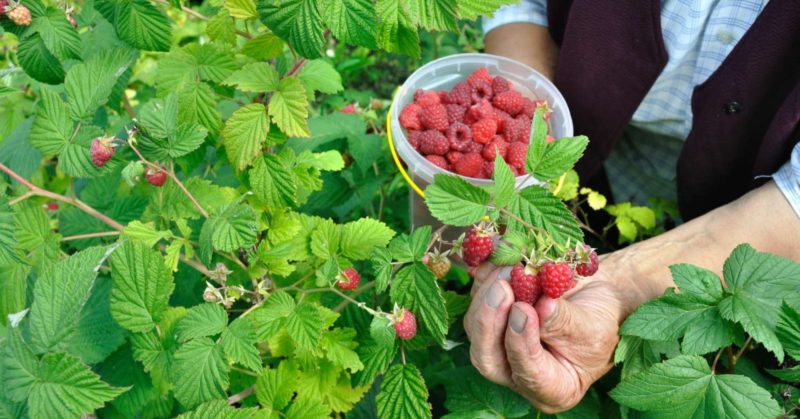
How to care for raspberries in July:
- Fertilization. After fruiting, the plants are depleted and need additional nutrition.
- Pruning fruiting shoots... They have already fulfilled their function and will no longer bear fruit, so you should not feel sorry for them.
- Thinning young shoots... Raspberries actively form young shoots, and if they are not thinned, this will lead to thickening of the plantings, diseases and a decrease in yield.
- Preventive treatment against various pests and diseases.
- Watering. As necessary, depending on weather conditions, soil and location of the raspberry tree.
Do not forget about regular weeding and loosening of the soil around the bushes.
Post-harvest care steps
Let's tell you more about what to do with raspberries after fruiting.
Pruning
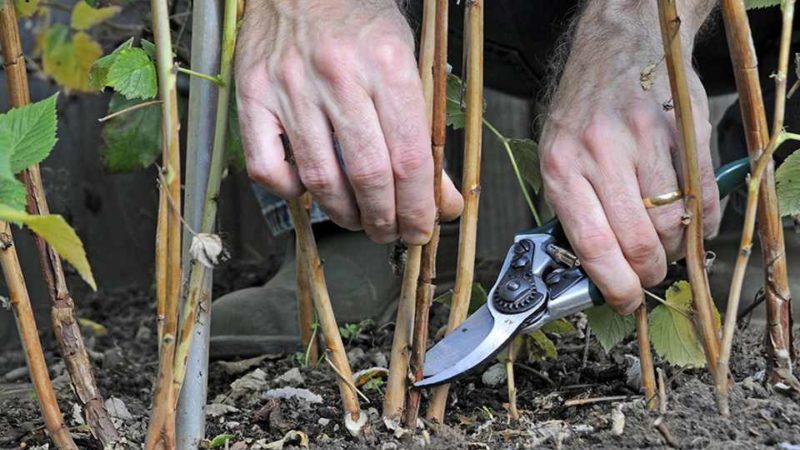
After the crop is harvested, all two-year-old woody stems are removed. They won't bloom next summer, fruits won't form... You can postpone pruning until spring, but in this case, the old growth will rob the bush of the nutrients it needs for a successful wintering.
During July pruning, remove all stems that have produced fruit in the current season. Cut from the sharp pruning shears to the base, leaving no hemp. This will allow the plant to direct all its energies to the growth and development of young shoots that will bear fruit in the next season.
Normalization
In addition to old shoots, numerous young shoots are cut (rationed) at the base of the bush. They save no more than 5-6 strong stems for the next season (up to 14-16 pcs. Per running meter).
Be sure to remove all broken, dried, weak and diseased branches. Spider mites, the causative agent of purple spot, the larvae of the shoot and stem gall midges can survive on them.
Excess shoots are pruned at the base flush with the ground. All shoots that have appeared at a distance from the main bush are also removed. Otherwise, they will take food and moisture from the mother plant.
If you do not remove the weak growth, it will freeze in winter and then begin to rot, spreading mold and reducing the plant's immunity. All cut stems are burned to destroy pathogenic microorganisms and pests.
Important! Raspberries naturally have a powerful, constantly growing root system. If its growth is not limited, the shrub will creep over the territory of the garden, without spending energy on flowering and fruiting.
The recommended width of the raspberry tree is no more than 1 m. All shoots that appear outside this perimeter are cut out.This will prevent disease and provide light, moisture and nutrition.
Getting rid of old bushes
The raspberry bush constantly branches and year after year is understood higher and higher above the soil surface. As a result, the growth of young shoots is weakened. This usually occurs after 6-12 years (earlier in large-fruited varieties). Therefore, it is recommended to periodically remove (carve) old bushes with a sharp shovel and burn them.
Top dressing
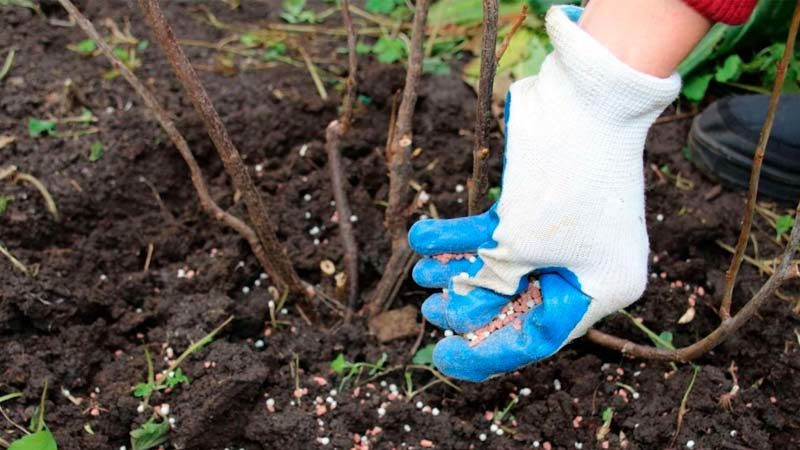
After pruning, normalizing and removing old plants, fertilizer is applied. The type of feeding and dosage depends on the soil... If the soil is poor, it is good to add potassium sulfate (1 tsp. Per 1 m²), after dissolving it in water. The substance will accelerate the maturation of wood before the onset of cold weather.
Once every 2-3 years, wood ash and compost are added for digging. Nitrogen fertilizers for feeding raspberries at the end of summer, they are not used, as they provoke the active growth of the shoots, which will not have time to ripen before the cold weather.
Phosphorus and potash fertilizers are applied into the furrows at a distance of at least 0.3 m from the bushes (for each 40 g of potassium salt and 60 g of superphosphate). From above they mulch with peat with a layer of 2-3 cm. In plants fed in this way, the laying of flower buds is improved, which increases productivity.
With a lack of magnesium, the leaves turn yellow from the center to the edges and fall off prematurely, and with a lack of boron in the spring, buds and lateral branches do not develop. Magnesium fertilizers are applied in the form of magnesium sulfate (25-35 g / m²) together with other fertilizers. Boron (borax) is applied in the spring (1.5-2 g / m²).
Watering

In July, raspberries are watered only if the weather is dry. In this case, the topsoil is moistened with water by 0.3-0.4 m.
In autumn (before frost), rare watering is also carried out. This will protect the bushes from drying out in winter, prepare them for the cold weather, and allow the plant to establish root buds.
Using mulch in the summer can reduce the number of waterings.
Protection against diseases and pests
Protection of raspberries from pests begins with simple agrotechnical measures: pruning, removal and burning of plant residues, timely digging of the top layer of the earth near the bushes.
Attention! Weevils, gall midges, beetle larvae hibernate in damaged or dead parts of the bush and in the soil. Removing fallen leaves, dried and diseased shoots will not only improve the appearance of the raspberry tree, but also protect it from diseases and pests.
Timely cleaning and thinning of the bushes allows you to minimize the use of chemical agents to combat pests and pathogens.
In the second half of summer or autumn, the aisles in the garden are dug up or bayonetted. It is an effective measure against raspberry beetle, weevil, raspberry stem fly, gall midge, raspberry and spider mites.
Burning plant residues helps in the fight against weevils and gall midges, as well as pathogens of purple spot, septoria, anthracnose, and rust.
Dusting the soil with a thick layer of mulch prevents diseases from developing and prevents the reproduction of pests (weevil, raspberry stem fly, gall midge).
After harvesting, a 5% Bordeaux liquid is applied. The drug carefully cultivate all bushes from bottom to top. The procedure is carried out in clear weather, the shoots must be dry. From insecticides used, for example, "Allegro" or "Aktara". These are complex preparations aimed at combating a number of pests.
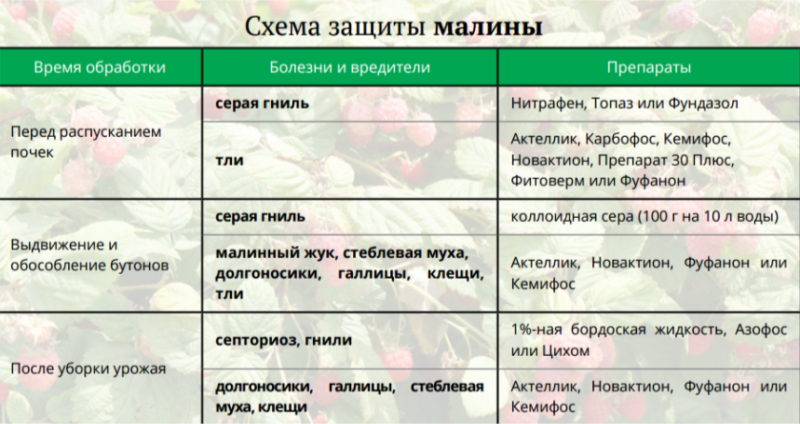
Features of caring for remontant raspberries
When growing remontant raspberries pruning and others listed above stages of care carried out in the fall, after the second harvest. All fruiting shoots are cut out (they are brown in color) and weak root growth, and in annual green shoots, the tops are shortened by 15-25 cm.
The intensive growth and fruiting of remontant raspberries require careful attention. to fertilizing - without additional nutrition, the harvest will be poor. The culture is especially sensitive to a lack of nitrogen (it is applied in early spring) and phosphorus-potassium fertilizers (added when digging in the fall or during flowering).
Another care feature for remontant raspberries due to the superficial location of its root system. Therefore, plants often suffer from a lack of moisture and overheating of the soil in summer. Regular watering helps to solve the first problem, and the second is mulching the soil in the raspberry tree.
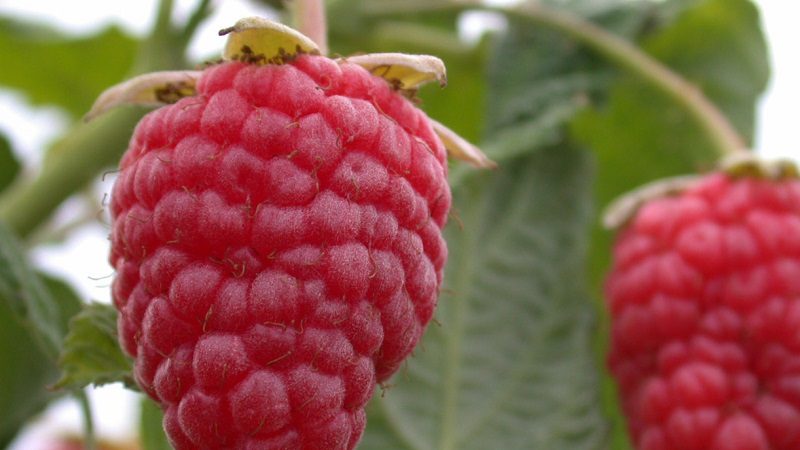
Autumn care
Autumn planting care consists in the removal of plant residues and mulch. They are removed and burned along with the pests that have settled there. The soil surface is carefully dug to a depth of 8-10 cm.
If necessary, potash-phosphorus fertilizers are applied. In regions with harsh winters, raspberry shoots are sheltered to protect them from freezing.
Experienced gardening tips
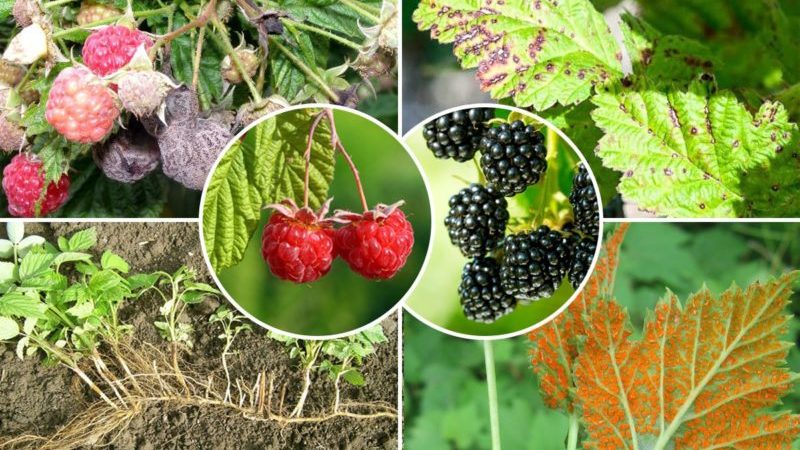
If you plan to expand the raspberry tree, experienced gardeners recommend preparing planting holes and trenches in the second half of summer. A new place is prepared no later than 6 weeks before the day of disembarkation. The selected area is dug to the depth of the shovel bayonet, removing the roots of weeds along the way, and 0.2-0.4 kg of superphosphate, 2-3 buckets of rotted manure and 100-200 g of potassium sulfate per 1 m² of the plot are added.
If the soil is properly fertilized before planting the plants, they will not need phosphorus and potassium dressings for another 4-5 years. If the soil is peaty, 4 buckets of sand are added for every 1 m² of the plot.
They start planting in late September - early October. Then the seedlings will have time to take root before the arrival of cold weather and in the spring will begin to actively grow.
Conclusion
In order to please loved ones with a harvest of tasty and healthy berries every summer, enough attention should be paid to raspberries immediately after fruiting.
Timely removal of fertile, weak and diseased shoots, as well as rationing of the bushes will allow the plant to direct all its efforts to the growth and development of branches on which berries will grow in the next season.